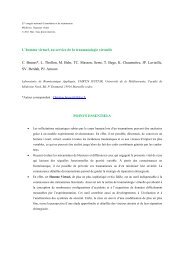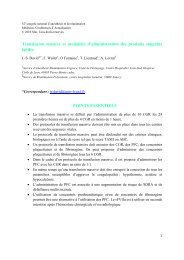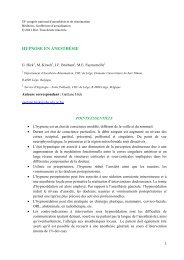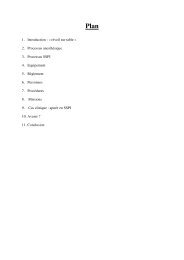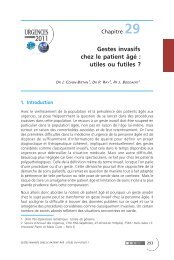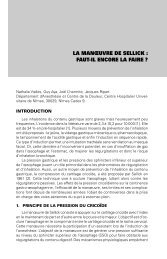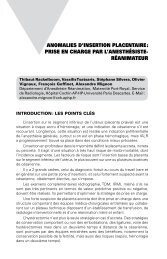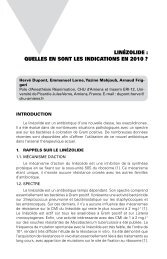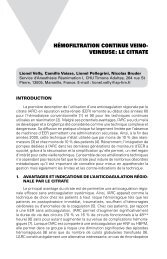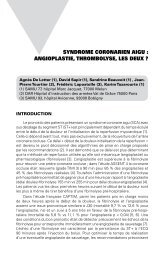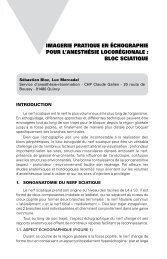Principe technologique MetroDoloris est le premier acteur - Société ...
Principe technologique MetroDoloris est le premier acteur - Société ...
Principe technologique MetroDoloris est le premier acteur - Société ...
Create successful ePaper yourself
Turn your PDF publications into a flip-book with our unique Google optimized e-Paper software.
<strong>Principe</strong> <strong>technologique</strong><br />
<strong>MetroDoloris</strong> <strong>est</strong> <strong>le</strong> <strong>premier</strong> <strong>acteur</strong> industriel en mesure de proposer aux cliniciens une<br />
technologie fiab<strong>le</strong> et continue d’évaluation de l’analgésie.<br />
<strong>MetroDoloris</strong> c'<strong>est</strong> :<br />
• Une technologie simp<strong>le</strong> de mise en œuvre, continue et non invasive de monitorage de<br />
l’analgésie patient.<br />
• Une société issue de l'innovation médica<strong>le</strong>.<br />
De nombreuses études ont prouvé que l’analyse de l’arythmie sinusa<strong>le</strong> respiratoire, reflète<br />
<strong>le</strong> comportement du Système Nerveux Autonome (SNA), lui-même influencé par la<br />
stimulation nociceptive.<br />
Notre technologie a permis de mettre au point des indices liés à l’effet de la dou<strong>le</strong>ur sur<br />
l’organisme du patient. Les validations cliniques se multiplient en per et post-opératoire et<br />
font état de la spécificité et sensibilité de notre indice : Analgesia Nociception Index®.<br />
La technologie ANI <strong>est</strong> protégée par deux brevets internationaux propriété de la société<br />
<strong>MetroDoloris</strong>.<br />
Les morphiniques / opioïdes ont une action sous cortica<strong>le</strong>. C’<strong>est</strong> donc logiquement vers la<br />
recherche d’un moyen d’analyse du tonus du Système Nerveux Autonome (SNA) que notre<br />
recherche s’<strong>est</strong> orientée. L’analyse du SNA semb<strong>le</strong> être, en effet au regard des publications<br />
sur <strong>le</strong> sujet, <strong>le</strong> meil<strong>le</strong>ur moyen d’obtenir un point de vue sur l’activité sous cortica<strong>le</strong>.<br />
Dans <strong>le</strong> souci de fournir aux cliniciens un système de monitorage fiab<strong>le</strong> de l’analgésie<br />
patient répondant aux impératifs de la pratique clinique courante (simp<strong>le</strong> d’utilisation,<br />
d’interprétation, fiab<strong>le</strong> et continu), c’<strong>est</strong> la voie d’accès au SNA via l’ECG patient qui attira<br />
notre attention.<br />
De toutes <strong>le</strong>s technologies qui se sont intéressées à cette voie, notre technologie <strong>est</strong> la seu<strong>le</strong> à<br />
prendre <strong>le</strong> contre-pied des précédentes tentatives. Basé sur la balance sympatho-vagua<strong>le</strong>,<br />
c’<strong>est</strong> en effet <strong>le</strong> tonus parasympathique qui nous intéresse et non l’activité sympathique,<br />
extrêmement diffici<strong>le</strong> à extraire du spectre ECG, tant, celui-ci se combine à d’autres f<strong>acteur</strong>s<br />
dans <strong>le</strong>s mêmes zones fréquentiel<strong>le</strong>s.
L’analyse spectra<strong>le</strong> du signal ECG permet d’identifier plusieurs zone fréquentiel<strong>le</strong>s dont <strong>le</strong>s<br />
influences sont diverses. La zone « hautes fréquences » ne comporte que des informations<br />
relatives au tonus parasympathique. C’<strong>est</strong> cette zone fréquentiel<strong>le</strong> qui fait l’objet de notre<br />
analyse.<br />
C’<strong>est</strong>, majoritairement, l’Arythmie Respiratoire Sinusa<strong>le</strong> (ARS), qui possède une influence<br />
sur la zone « hautes fréquences »<br />
L’ARS résulte de l’influence du tonus parasympathique de l’organisme sur <strong>le</strong> nœud sinusal<br />
cardiaque. En effet, dans l’unique optique de fournir aux cellu<strong>le</strong>s un nécessaire apport en<br />
métabolite constant l’organisme se doit de préserver un débit cardiaque stab<strong>le</strong>. Or,<br />
l’inspiration provoque une surpression pulmonaire, se transmettant au péricarde via <strong>le</strong><br />
diaphragme et diminuant la capacité de dilatation ventriculaire donc <strong>le</strong> volume d’éjection<br />
systolique (VES). A l’inverse, l’expiration et la dépression pulmonaire qui en résulte<br />
permettent alors aux ventricu<strong>le</strong>s de se dilater confortab<strong>le</strong>ment, assurant ainsi un volume<br />
d’éjection systolique maxima<strong>le</strong>.<br />
Le débit cardiaque (DC) répond à la formu<strong>le</strong> : DC = Fc x VES<br />
On comprend donc pourquoi, pour maintenir un débit constant, l’organisme augmente la<br />
fréquence cardiaque à l’inspiration et la diminue à l’expiration. C’<strong>est</strong> l’arythmie respiratoire<br />
sinusa<strong>le</strong> (ARS).<br />
Cette fonction de modérateur <strong>est</strong> essentiel<strong>le</strong>ment assurée par la bouc<strong>le</strong> ref<strong>le</strong>xe<br />
parasympathique faisant afférence au sein du nœud pulmonaire du tractus solitaire et fait<br />
synapse au niveau du noyau du nerf vague, <strong>le</strong> nœud sinusal.
La technologie ANI fournit ainsi un indice fiab<strong>le</strong>, continu et simp<strong>le</strong> de recueil du tonus<br />
parasympathique patient. L’algorithme d’interprétation du tonus parasympathique se présente<br />
de la manière suivante :<br />
Tonus p∑ = Réaction à la nociception + stress psychologique<br />
Considérant un patient inconscient (per-opératoire et post opératoire « lourd » tel<strong>le</strong> que <strong>le</strong>s<br />
patients sous sédation prononcée en réanimation), la composante « stress psychologique »<br />
s’annu<strong>le</strong>. L’indice ANI fourni doit donc s’interpréter comme un indice objectif de l’analgésie<br />
patient.<br />
Considérant un patient conscient, la composante « stress psychologique » doit être prise en<br />
compte. Le clinicien saura en administrant successivement au patient morphiniques puis<br />
anxiolytiques, vu <strong>le</strong>s répercutions sur l’ANI, laquel<strong>le</strong> des deux thérapeutiques <strong>est</strong> la plus<br />
adaptée au patient en qu<strong>est</strong>ion.<br />
En per-opératoire comme pour tout patient non communiquant, seu<strong>le</strong> notre technologie <strong>est</strong><br />
en mesure de fournir au clinicien une évaluation fiab<strong>le</strong>, continue, non opérateur dépendante<br />
et simp<strong>le</strong> d’utilisation de l’analgésie patient. Le principe de fonctionnement en <strong>est</strong> <strong>le</strong><br />
suivant :<br />
a) Acquisition du signal ECG :<br />
L’ECG <strong>est</strong> acquis au moyen d’é<strong>le</strong>ctrodes cutanées reliées à un dispositif é<strong>le</strong>ctronique<br />
d’amplification et de numérisation (amplificateur ECG). Le signal ECG numérisé <strong>est</strong><br />
ensuite soumis à différents traitements afin de calcu<strong>le</strong>r la fréquence cardiaque instantanée<br />
(FCI), de construire la série des interval<strong>le</strong>s RR et d’en extraire <strong>le</strong>s indices liés au niveau de<br />
dou<strong>le</strong>ur.<br />
b) Construction de la série RR :<br />
Le signal ECG <strong>est</strong> constitué d’une suite d’ondes représentatives de la contraction et<br />
décontraction cardiaque. L’onde P caractérise la contraction des oreil<strong>le</strong>ttes, l’onde QRS la<br />
contraction des ventricu<strong>le</strong>s et l’onde T la repolarisation (décontraction) des cellu<strong>le</strong>s<br />
myocardiques ventriculaires (figure 1).<br />
L’onde QRS <strong>est</strong> l’onde la plus amp<strong>le</strong> du signal. La détection de son sommet R permet une<br />
bonne précision sur <strong>le</strong> calcul des interval<strong>le</strong>s de temps entre chaque onde R, donc entre chaque<br />
contraction ventriculaire. Le RR représente la période cardiaque instantanée. La<br />
visualisation de la suite des interval<strong>le</strong>s RR permet de suivre l’évolution temporel<strong>le</strong> de la<br />
période cardiaque instantanée. Ce sont <strong>le</strong>s variations de cette série RR (figure 2),<br />
significatives de l’action du Système Nerveux Autonome (SNA) sur <strong>le</strong> rythme cardiaque, qui<br />
sont analysées pour extraire <strong>le</strong>s indices liés au niveau de dou<strong>le</strong>ur.
c) Filtrage de la série RR (mise en œuvre du Brevet 1) :<br />
Le signal ECG, bien que faci<strong>le</strong>ment enregistrab<strong>le</strong> de façon non invasive, peut être perturbé<br />
par bon nombre d’artéfacts (mouvements du patient, extrasysto<strong>le</strong>s, etc.) qui, en altérant la<br />
série RR, rendent tout calcul caduque. Ceci constitue un obstac<strong>le</strong> majeur si l’on souhaite<br />
traiter <strong>le</strong> signal en temps réel.<br />
Pour remédier à ce problème nous avons mis au point un procédé intelligent qui a pour objet<br />
de filtrer en temps réel, la série RR (Brevet 1). Le principe repose sur la détection et <strong>le</strong><br />
remplacement, dans la série RR, des échantillons erronés. Les échantillons erronés sont<br />
remplacés par des échantillons corrigés. Ainsi, <strong>le</strong>s zones perturbées de la série RR sont<br />
reconstituées de façon vraisemblab<strong>le</strong> tout en gardant l’information temporel<strong>le</strong> de<br />
l’enregistrement. La figure 3 illustre l’effet de ce filtre sur un enregistrement perturbé.<br />
d) Calcul des indices liés à la dou<strong>le</strong>ur (mise en œuvre du Brevet 2) :<br />
En dehors de toute influence extérieure, <strong>le</strong> cœur possède son propre rythme, très régulier,<br />
insufflé par son pacemaker naturel, <strong>le</strong> nœud sinusal, véritab<strong>le</strong> horloge biologique. Mais ce<br />
nœud sinusal, situé au niveau des tissus de l’oreil<strong>le</strong>tte droite, n’<strong>est</strong> pas isolé. Il <strong>est</strong> relié au<br />
Système Nerveux Autonome (SNA) par sa branche sympathique (voie accélératrice) et sa<br />
branche parasympathique (voie modératrice). Ce sont ces actions du SNA qui induisent <strong>le</strong>s<br />
modulations de rythme cardiaque. Il <strong>est</strong> donc évident que l’analyse mathématique de ces<br />
variations instantanées donne une image de l’activité du SNA.<br />
De nombreuses observations de séries RR enregistrées lors d’an<strong>est</strong>hésies généra<strong>le</strong>s ont montré<br />
des modifications morphologiques de l’enregistrement de la série RR au cours d’épisodes<br />
douloureux tels que, par exemp<strong>le</strong>, l’incision chirurgica<strong>le</strong>. La figure 4a montre une série RR<br />
chez un patient an<strong>est</strong>hésié en état stab<strong>le</strong>. On remarque des modulations respiratoires<br />
régulières et de grande amplitude. A contrario, la figure 4b, enregistrée lors d’une<br />
stimulation chirurgica<strong>le</strong>, montre une série RR plus chaotique et de faib<strong>le</strong> amplitude.
e) Calcul des indices :<br />
Nous avons développé des algorithmes de calcul basés sur la mesure d’amplitude des<br />
modulations respiratoires de la série RR. Mais pour tenir compte à la fois des variations<br />
d’amplitude et de période des modulations respiratoires, nous avons adopté <strong>le</strong> principe de<br />
mesure de surfaces sous la courbes de la série RR (figure 5) dit AUCmin (Minima of the<br />
Areas Under the Curve).<br />
Nous sommes alors en mesure de fournir une évaluation continue (recalculée toute <strong>le</strong>s 4<br />
secondes) de l’analgésie patient.<br />
Nous avons d’abord t<strong>est</strong>é ces indices dans <strong>le</strong> cadre de l’an<strong>est</strong>hésie généra<strong>le</strong> lors de<br />
protoco<strong>le</strong>s cliniques dont l’objectif était d’évaluer la composante analgésique de<br />
l’an<strong>est</strong>hésie. Puis nous avons évalué <strong>le</strong>s mêmes indices dans <strong>le</strong> cadre de l’analgésie<br />
péridura<strong>le</strong> chez la parturiente, avant et après installation de l’analgésie péridura<strong>le</strong>. Ces t<strong>est</strong>s<br />
ont montré la pertinence de nos paramètres dans l’évaluation du niveau d’analgésie (ou<br />
niveau de dou<strong>le</strong>ur) dans de tel<strong>le</strong>s applications.<br />
Références de l'équipe de recherche<br />
___<br />
Brevets :<br />
1. Logier R., Dassonnevil<strong>le</strong> A. - Procédé et dispositif de filtrage d’une série RR issue d’un<br />
signal cardiaque, et plus particulièrement d’un signal ECG – Brevet - France,<br />
FR2821460 B1, 28/02/2001- PCT WO 2002/069178 A3, 11/02/2002 – Europe, EP1366428<br />
A2, 11/02/2002.<br />
2. Logier R., Dassonnevil<strong>le</strong> A. – Méthode de traitement fréquentiel d’une série RR, procédé et<br />
système d’acquisition et de traitement d’un signal cardiaque analogique, et application à la<br />
mesure de la souffrance fœta<strong>le</strong> – France, N° 02 06676, 31/05/2002 - PCT FR03/01226,
16/04/2003.<br />
3. Régis Logier, Mathieu Jeanne, Benoît Tavernier – Procédé et dispositif d’évaluation de la<br />
dou<strong>le</strong>ur chez un être vivant – Brevet - Europe, EP1804655 A1, 20/09/2004 - Etats-Unis, US<br />
20080132801, 05/06/2008 - Canada, 2 580 758, 09/08/2005 - Japon, P2008-513073A,<br />
01/05/2008.<br />
4. Logier R., Jeanne M., Tavernier B. – Method and device for assessing the depth of<br />
analgesia during general ana<strong>est</strong>hesia – Provisional Application N° EV 406 076 745, USA,<br />
15/04/2004.<br />
Publications et communications :<br />
1. Logier R., Dagano J., Kacet S., Lacroix D., Car<strong>le</strong>s O., Libersa C., Fiévé R., Lekieffre J. -<br />
Analyse spectra<strong>le</strong> de la variabilité de la fréquence cardiaque : développement d'une station<br />
d'acquisition et de traitement - R.B.M. 1990; 12, 1: 32-34.<br />
2. De<strong>le</strong>croix M., Roumazeil<strong>le</strong> B., Logier R., Decoulx J. - Problèmes an<strong>est</strong>hésiologiques posés<br />
par un g<strong>est</strong>e chirurgical sur une métastase osseuse d'un phéochromocytome malin - Journées<br />
d'Orthopédie et de Traumatologie de Lil<strong>le</strong>, 29 Juin 1990.<br />
3. Lacroix D., Kacet S., Dagano J., Logier R., Hazard J.R., Loubeyre C., Lekieffre J. -<br />
Response of respiratory sinus arrhythmia to central (tropatepine) and peripheral (prifinium)<br />
anticholinergic agents - American Heart Association, 63rd Scientific Sessons, Dallas (USA)<br />
November 12th-15th 1990; Circulation 82 : (Suppl III) III-333.<br />
4. Lacroix D., Logier R., Kacet S., Hazard J.R., Dagano J., Lekieffre J. - Effects of<br />
consecutive administration of central and peripheral anticholinergic agents on respiratory<br />
sinus arrhythmia in normal subjects - Journal of the Autonomic Nervous System, 1992; 39 :<br />
211-218.<br />
5. Lacroix D., Logier R., Kacet S., Dagano J., Lekieffre J. - Analyse spectra<strong>le</strong> de la variabilité<br />
de la fréquence cardiaque chez l'homme : intérêt pour étudier l'équilibre vago-sympathique -<br />
<strong>Société</strong> Française de Cardiologie, Paris, Janvier 1992.<br />
6. Géhin A.L., Logier R., Bayart M., Staroswiecki M., De<strong>le</strong>croix M., Cantineau D. - Data<br />
validation for improving ana<strong>est</strong>hesia supervision - Conference proceedings of IEEE<br />
Intenational Conference on Systems, Man and Cybernetics. Vol 3, 67-71, 1993.<br />
7. Géhin A.L., Logier R., Bayart M., Staroswiecki M., Cantineau D., De<strong>le</strong>croix M. -<br />
Application of the smart sensor concept to the ana<strong>est</strong>hesia supervision - Proceedings of the<br />
15th Annual International Conference of the IEEE Engineering in Medicine and Biology<br />
Society. Vol 15, (2), 616-617, 1993.<br />
8. Guedon-Moreau L., Pinaud A., Logier R., Caron J., Lekieffre J., Dupuis B., Libersa C. -<br />
Effect of ramipril on heart rate variability in digitalis-treated patients with chronic heart<br />
failure - Cardiovasc. Drugs Ther., 1997 sep. ; 11(4) : 531-536.<br />
9. Ganga P-S., Racoussot S., Storme L., Logier R., Riou Y., Lacroix D., Truffert P.,<br />
Klosowski S., Lequien P. - Analyse spectra<strong>le</strong> (AS) tridimensionnel<strong>le</strong> de la variabilité du<br />
rythme cardiaque chez <strong>le</strong> nouveau-né - Journées Francophones de Recherche en<br />
Néonatologie. Arch. Fr. Pédiatr. 1997, 9 : 917.<br />
10. Ganga-Zandzou P.S., Carpentier C., Logier R., Pierrat V., Rakza T., Riou Y., Dubois A.,<br />
Liska A., Storme L., Lequien P. - Etude de la variabilité du rythme cardiaque chez <strong>le</strong>s<br />
nourrissons porteurs d’une hypertonie vaga<strong>le</strong> - Journées Francophones de Recherche en<br />
Néonatologie 1997.<br />
11. Kouakam C., Lacroix D., Zghal N., Logier R., Lekieffre J., Kacet S. - Inadaptation<br />
sympathovaga<strong>le</strong> en réponse à l’orthostatisme : un prédicteur indépendant du résultat du t<strong>est</strong><br />
d’inclinaison - Colloque Européen de Vectocardiographie et d’E<strong>le</strong>ctrocardiographie<br />
Quantitative, Lil<strong>le</strong>, 1997.
12. Régis Logier, Dominique Lacroix, Laurent Storme, Michel De<strong>le</strong>croix - Continuous<br />
spectral analysis of heart rate variability - World congress on medical physics and<br />
biomedical engineering, september 14-19, 1997 Nice, France.<br />
13. Claude Kouakam, Dominique Lacroix, Nazih Zghal, Didier Klug, Pierre Le Franc,<br />
Mustapha Jarwe, Régis Logier, Sa<strong>le</strong>m Kacet - Prediction of tilt t<strong>est</strong> result by power spectral<br />
analysis of heart rate variability - American Col<strong>le</strong>ge of Cardiologie, 47th Annual Scientific<br />
Session.<br />
14. R. Logier, D. Lacroix, L. Storme, M. De<strong>le</strong>croix - A monitoring device for continuous<br />
analysis of heart rate variability - Proceedings - 19th International Conference - IEEE/EMBS<br />
Oct. 30 - Nov. 2, 1997 Chicago, IL. USA, pp 321-322.<br />
15. Kouakam C., Lacroix D., Zghal N., Logier R., Klug D., Le Franc P., Jarwe M., Kacet S. –<br />
Inadequate sympathovagal balance in response to orthostatism in patients with unexplained<br />
syncope and a positive head up tilt t<strong>est</strong> – Heart, Vol. 82, 1999, P 312-318.<br />
16. Ganga-Zandzou PS., Carpentier C., Logier R., Pierrat V., Rakza T., Riou Y., Dubois A.,<br />
Liska A., Storme L., Lequien P. – Etude de la variabilité du rythme cardiaque chez <strong>le</strong>s<br />
nourrissons porteurs d’une hypertonie vaga<strong>le</strong> – Arch. Fr. Pédiatr. 1999, 3 : 361.<br />
17. Logier R., Matis R., De jonckheere J. – Analyse spectra<strong>le</strong> du rythme cardiaque fœtal<br />
pendant <strong>le</strong> travail obstétrical : étude de faisabilité – ITBM-RBM ; 22 : 31-7, 2001.<br />
18. Bruno Marciniak, Anne Hebrard, Fabrice Moll, Régis Logier, Patrick Loeb – Spectral<br />
analysis of heart rate variability in children undergoing general ana<strong>est</strong>hesia – American<br />
Society of Ana<strong>est</strong>hesiology, Orlando, 2002.<br />
19. Jeanne M., Logier R., Tavernier B. - Variabilité sinusa<strong>le</strong> du rythme cardiaque : quels<br />
paramètres reflètent la profondeur de la composante analgésique de l’an<strong>est</strong>hésie généra<strong>le</strong> ? -<br />
Ann Fr An<strong>est</strong>h Réanim 2004; 23: R 204.<br />
20. Jeanne M., Logier R., Tavernier B. - Heart Rate Variability: which paramaters do assess<br />
depth of analgesia during general ana<strong>est</strong>hesia ? – EHS-BAVAR, International Conferences<br />
of Cardiology, Angers – France – June 11 & 12th 2004.<br />
21. Jeanne M., Logier R., Tavernier B. - Variabilité sinusa<strong>le</strong> du rythme cardiaque : mesure<br />
de l’analgésie sous an<strong>est</strong>hésie généra<strong>le</strong> ? – Abstract <strong>Société</strong> Française d’An<strong>est</strong>hésie<br />
Réanimation, Avril 2004.<br />
22. Jeanne M., Logier R., Tavernier B. - Variabilité sinusa<strong>le</strong> du rythme cardiaque : mesure de<br />
l'analgésie sous an<strong>est</strong>hésie généra<strong>le</strong> ? – Communication <strong>Société</strong> Française d’Informatique<br />
pour <strong>le</strong> Monitorage en An<strong>est</strong>hésie Réanimation, Avril 2004.<br />
23. R. Logier, J. De Jonckheere, A. Dassonnevil<strong>le</strong> – An efficient algorithm for R-R intervals<br />
series filtering - Proceedings of the 26th Annual International Conference of the IEEE<br />
Engineering in Medicine and Biology Society. 2004.<br />
24. Logier R., Jeanne M., Tavernier B., De jonckheere J. Pain / Analgesia evaluation using<br />
heart rate variability analysis. - Proceeding of the 28th Annual International conference of<br />
the IEEE Engineering in the Medicine and Biology Society. New York, 2006.<br />
25. Logier R, De jonckheere, Jeanne R., Matis R. – Fetal distress diagnosis using heart rate<br />
variability analysis : Design of a high frequency variability index - Proceeding of the 30th<br />
Annual International conference of the IEEE Engineering in the Medicine and Biology<br />
Society, Vancouver, Canada, September 2008.<br />
26. Jeanne M, Logier R, De jonckheere J, Tavernier B – Heart rate variability to assess<br />
analgesia/nociception during general an<strong>est</strong>hesia – Autonomic Neuroscience: basic and<br />
clinical, february 2009.<br />
27. Jeanne M., Logier R., J. De jonckheere, B. Tavernier – Validation of a graphic<br />
measurement of heart rate variability to assess analgesia/nociception during general<br />
an<strong>est</strong>hesia - Proceeding of the 31th Annual International conference of the IEEE Engineering<br />
in the Medicine and Biology Society, Minneapolis, USA, September 2009.
28. Kuissi Kamgaing E, De jonckheere J, Logier R, Faye MP, Jeanne M, Rakza T, Pennaforte<br />
T, Mur S, Fily A, Storme L – Effet du positionnement sur <strong>le</strong> contrô<strong>le</strong> de la fréquence<br />
cardiaque chez l’enfant prématuré - 15ème journées francophone de recherche en<br />
néonatologie (JFRN), Paris, Novembre 2009.<br />
29. Faye M, Kuissi E, De jonckheere, Logier R, Jeanne M, Rakza T, Storme L – Evaluation<br />
de la dou<strong>le</strong>ur néonata<strong>le</strong> par analyse de la variabilité du rythme cardiaque - 15ème journées<br />
francophone de recherche en néonatologie (JFRN), Paris, Novembre 2009.<br />
30. Logier R., Jeanne M., De jonckheere J., Dassonnevil<strong>le</strong> A., De<strong>le</strong>croix M., Tavernier B. –<br />
Physiodoloris: a monitoring device for analgesia / nociception balance evaluation using heart<br />
rate variability analysis - Proceeding of the 32th Annual International conference of the IEEE<br />
Engineering in the Medicine and Biology Society, Buenos Aires, Argentina, September 2010.<br />
31. Jeanne M., De jonckheere J., Logier R., Tavernier B. – Mise au point d’une mesure<br />
graphique de la variabilité sinusa<strong>le</strong> du rythme cardiaque pour l’<strong>est</strong>imation de la balance<br />
analgésie / nociception : l’Anakgesia Nociception Index (ANI) – congrès annuel de la <strong>Société</strong><br />
Française d’An<strong>est</strong>hésie Réanimation (SFAR), septembre 2010, Paris, France.<br />
32. Lafanechère A., Jeanne M., Lenci H., Debail<strong>le</strong>ul A.-M., Logier R., Tavernier B. –<br />
Evaluation de la balance analgésie nociception par la réactivité du diamètre pupilaire et la<br />
mesure de l’ « analgesia nociception index » sous an<strong>est</strong>hésie généra<strong>le</strong> – congrès annuel de la<br />
<strong>Société</strong> Française d’An<strong>est</strong>hésie Réanimation (SFAR), septembre 2010, Paris, France.<br />
33. Le Guen M., Almoubarik M., Jeanne M., Chazot T., Logier R., Fisch<strong>le</strong>r M. – L’Analgesia<br />
Nociception Index (ANI), moniteur de la dou<strong>le</strong>ur : étude pilote – congrès annuel de la <strong>Société</strong><br />
Française d’An<strong>est</strong>hésie Réanimation (SFAR), septembre 2010, Paris, France.<br />
34. Faye PM., De jonckheere J., Logier R., Kuissi E., Jeanne M., Rakza T., Storme L. –<br />
Newborn infant pain assessment using heart rate variability analysis – Accepted for<br />
publication, Clinical journal of pain, 2010.<br />
Masters et thèses :<br />
1. Moll F. Analyse spectra<strong>le</strong> de la fréquence cardiaque chez l’enfant au cours de l’an<strong>est</strong>hésie<br />
généra<strong>le</strong>. Thèse pour <strong>le</strong> Doctorat en médecine. Université de Lil<strong>le</strong> II. 1999.<br />
2. Naouar M. Analyse temps-fréquence des signaux bioé<strong>le</strong>ctriques – Contribution à<br />
l’élaboration d’un outil d’inv<strong>est</strong>igation du système nerveux autonome – Thèse pour <strong>le</strong> titre de<br />
docteur de l’université du droit et de la santé de Lil<strong>le</strong>. 1999.<br />
3. Ardiet E. Intérêt de l'analyse fréquentiel<strong>le</strong> de la variabilité du rythme cardiaque fœtal<br />
comme marqueur de l'acidose fœta<strong>le</strong> pendant <strong>le</strong> travail obstétrical : Etude de faisabilité.<br />
Thèse pour <strong>le</strong> Doctorat en médecine. Université de Lil<strong>le</strong> II. 2000.<br />
4. Matis R. Analyse spectra<strong>le</strong> du rythme cardiaque fœtal pendant <strong>le</strong> travail : étude de<br />
faisabilité. Thèse pour <strong>le</strong> titre de docteur de l’université du droit et de la santé de Lil<strong>le</strong>. 2000.<br />
5. Ardiet E. Analyse quantitative de la variabilité du rythme cardiaque fœtal pendant <strong>le</strong><br />
travail ; recherche d’un paramètre de souffrance fœtal. DEA Sciences et Technologies<br />
(Majeur Génie Biomédical). Université de Technologies de Compiègne. 2001.<br />
6. Bourgain A. Optimisation de l’IVHF : Indice de Variabilité des Hautes Fréquences.<br />
Nouveau paramètre de dépistage de la souffrance foetal au cours du travail. DEA Sciences et<br />
Technologies (Majeur Génie Biomédical). Université de Technologies de Compiègne. 2003.<br />
7. De jonckheere J. Modelisation de la régulation du système cardiovasculaire par <strong>le</strong> système<br />
nerveux autonome. DEA d’Automatique et d’Informatique Industriel<strong>le</strong>. Université des<br />
sciences et technologies de Lil<strong>le</strong> I. 2003.<br />
8. Jeanne M. Mesure de la variabilité sinusa<strong>le</strong> du rythme cardiaque pour apprécier la<br />
composante analgésique de l'an<strong>est</strong>hésie généra<strong>le</strong>. DEA Sciences et Technologies (Majeur<br />
Génie Biomédical). Université de Technologies de Compiègne. 2004.
9. Jeanne M. Effet de l’analgésie péridura<strong>le</strong> sur l’activité du système nerveux autonome au<br />
cours du travail obstétrical. Thèse pour <strong>le</strong> Doctorat en médecine. Université de Lil<strong>le</strong> II. 2004.<br />
10. Jeanne M. Développement d’un système d’analyse de la variabilité du rythme cardiaque<br />
et application à l’évaluation de la nociception – Thèse pour <strong>le</strong> titre de docteur de l’université<br />
du droit et de la santé de Lil<strong>le</strong>. 2008.<br />
11. Avez-Couturier J. Application d’un système d’analyse de la variabilité du rythme<br />
cardiaque à l’évaluation de la dou<strong>le</strong>ur chez l’enfant, étude préliminaire – Master recherche<br />
mention Biologie Santé. Université de Lil<strong>le</strong> II. 2009.<br />
12. Avez-Couturier J. Evaluation de la dou<strong>le</strong>ur par l’analyse de la variabilité du rythme<br />
cardiaque chez l’enfant - Thèse pour <strong>le</strong> Doctorat en médecine. Université de Lil<strong>le</strong> II. 2010.<br />
Références internationa<strong>le</strong>s<br />
___<br />
1. Moser M, Lehofer M, Sedminek A, et al. Heart rate variability as a prognostic tool in<br />
cardiology. A<br />
contribution to the prob<strong>le</strong>m from a theoretical point of view. Circulation. 1994;90:1078-92.<br />
2. Altimiras J. Understanding autonomic sympathovagal balance from short term heart rate<br />
variations. Are we<br />
analysing noise ? Comp Biochem Physiol A Mol Integr Physiol. 1999;124:447-60.<br />
3. Lehrer PM, Vaschillo E, Vaschillo B. Resonant frequency biofeedback training to increase<br />
cardiac variability:<br />
rationa<strong>le</strong> and manual for training. Appl Psychophysiol Biofeedback. 2000;25:177-91.<br />
4. Berntson GG, Bigger JT Jr, Eckberg DL, et al. Heart rate variability: origins, methods, and<br />
interpretive caveats.<br />
Psychophysiology. 1997;34:623-48.<br />
5. Bernardi L, Leuzzi S, Radaelli A, Passino C, Johnston JA, S<strong>le</strong>ight P. Low-frequency<br />
spontaneous fluctuations<br />
of R-R interval and blood pressure in conscious humans: a baroreceptor or central<br />
phenomenon? Clin Sci (Lond).<br />
1994;87:649-54.<br />
6. Eckberg D. Sympathovagal balance : a critical appraisal. Circulation. 1997;96:3224-32.<br />
7. Porges SW. Orienting in a defensive world : mammalian modifications of our evolutionary<br />
heritage. A<br />
polyvagal theory. Psychophysiology. 1995;32:301-18.<br />
8. Ewing DJ, Martyn CN, Young RJ, Clarke BF. The value of cardiovascular autonomic<br />
function t<strong>est</strong>s: 10 years<br />
experience in diabetes. Diabetes Care. 1985;8:491-8.<br />
9. Wolf MM, Varigos GA, Hunt D, Sloman JG. Sinus arrhythmia in acute myocardial<br />
infarction. Med J Aust.<br />
1978;2:52-3.<br />
10. Akselrod S, Gordon D, Ubel FA, Shannon DC, Berger AC, Cohen RJ. Power spectrum<br />
analysis of heart rate<br />
fluctuation : a quantitative probe of beat-to-beat cardiovascular control. science.<br />
1981;213:220-2.<br />
11. Critch<strong>le</strong>y HD, Mathias CJ, Josephs O, et al. Human cingulate cortex and autonomic<br />
control: converging<br />
neuroimaging and clinical evidence. Brain. 2003;126:2139-52.
12. Critch<strong>le</strong>y HD. Neural mechanisms of autonomic, affective, and cognitive integration. J<br />
Comp Neurol.<br />
2005;493:154-66.<br />
13. Critch<strong>le</strong>y HD, Mathias CJ, Dolan RJ. Fear conditioning in humans: the influence of<br />
awareness and autonomic<br />
arousal on functional neuroanatomy. Neuron. 2002;33:653-63.<br />
14. Craig AD. A new view of pain as a homeostatic emotion. Trends Neurosci. 2003;26:303-<br />
7.<br />
15. Lacroix D, Logier R, Kacet S HJ, Dagano J, Lefieffre J. Effects of consecutive<br />
administration of central and<br />
peripheral anticholinergic agents on respiratory sinus arrythmia in normal subjects. J Auton<br />
Nerv Syst.<br />
1992;1992:211-8.<br />
16. Koh J, Brown TE, Beightol LA, Eckberg DL. Contributions of tidal lung inflation to<br />
human R-R interval and<br />
arterial pressure fluctuations. J Auton Nerv Syst. 1998;68:89-95.<br />
17. Kamath MV, Fal<strong>le</strong>n EL. Correction of the heart rate variability signal for ectopics and<br />
missing beats p75-85.<br />
Armonk; 1995.<br />
18. Friesen GM, Jannett TC, Jadallah MA, Yates SL, Quint SR, Nag<strong>le</strong> HT. A comparison of<br />
the noise sensitivity<br />
of nine QRS detection algorithms. IEEE Trans Biomed Eng. 1990;37:85-98.<br />
19. Pinna GD, Ma<strong>est</strong>ri R, Di Cesare A, Colombo R, Minuco G. The accuracy of powerspectrum<br />
analysis of heartrate<br />
variability from annotated RR lists generated by Holter systems. Physiol Meas. 1994;15:163-<br />
79.<br />
20. Heart rate variability. Standards of measurement, physiological interpretation and clinical<br />
use. Task Force of<br />
the European Society of Cardiology and the North American Society of Pacing and<br />
E<strong>le</strong>ctrophysiology. Circulation.<br />
1996;93:1043-65.<br />
21. Merri M, Farden DC, Mott<strong>le</strong>y JG, Tit<strong>le</strong>baum EL. Sampling frequency of the<br />
e<strong>le</strong>ctrocardiogram for spectral<br />
analysis of the heart rate variability. IEEE Trans Biomed Eng. 1990;37:99-106.<br />
22. K<strong>le</strong>iger RE, PK S, Bigger JT. Heart rate variability : measurement and clinical utility. Ann<br />
Noninvasive<br />
E<strong>le</strong>ctrocardiol. 2005;10:88-101.<br />
23. Task Force of The European Society of Cardiology and The North American Society of<br />
Pacing and<br />
E<strong>le</strong>ctrophysiology. Heart rate variability. Standards of measurement, physiological<br />
interpretation, and clinical use.<br />
Circulation, 1996:1043-65.<br />
MJ Bibliographie 02 11 2009<br />
Heart Rate Variability<br />
24. Malliani A, Lombardi F, Pagani M. Power spectrum analysis of heart rate variability: a<br />
tool to explore neural<br />
regulatory mechanisms. Br Heart J. 1994;71:1-2.<br />
25. Parlow JL, van Vlymen JM, Odell MJ. The duration of impairment of autonomic control<br />
after anticholinergic<br />
drug administration in humans. An<strong>est</strong>h Analg. 1997;84:155-9.
26. Ali-Melkkilä T, Kaila T, Kanto J. Glycopyrrolate : pharmakokinetics and some<br />
pharmacodynamics findings.<br />
Acta Ana<strong>est</strong>hesiol Scand. 1989;33:513-7.<br />
27. Ali-Melkkilä T, Kaila T, Antila K, Iisalo E. Effects of glycopyrrolate and atropine on<br />
heart rate variability.<br />
Acta Ana<strong>est</strong>hesiol Scand. 1991 35:436-41.<br />
28. Kanto J, Klotz U. Pharmacokinetic implications for the clinical use of atropine,<br />
scopolamine and<br />
glycopyrrolate. Acta Ana<strong>est</strong>hesiol Scand. 1988;32:69-78.<br />
29. Martinmäki K, Rusko H, Kooistra L, Kettunen J, Saalasti S. Intraindividual validation of<br />
heart rate variability<br />
indexes to measure vagal effects on hearts. Am J Physiol Heart Circ Physiol. 2006;290:H640-<br />
H7.<br />
30. Ikuta Y, Shimoda O, Kano T. Quantitative assessment of the autonomic nervous system<br />
activities during<br />
atropine-induced bradycardia by heart rate spectral analysis. J Auton Nerv Syst. 1995;52:71-<br />
6.<br />
31. Sinski M, Lewandowski J, Abramczyk P, Narkiewicz K, Gaciong Z. Why study<br />
sympathetic nervous system?<br />
J Physiol Pharmacol. 2006;57:79-92.<br />
32. Grassi G, Es<strong>le</strong>r M. How to assess sympathetic activity in humans. J Hypertens.<br />
1999;17:719-34.<br />
33. Es<strong>le</strong>r M, Jennings G, Korner P, et al. Assessment of human sympathetic nervous system<br />
activity from<br />
measurements of norepinephrine turnover. Hypertension. 1988;11:3-20.<br />
34. Macefield VG, Wallin BG, Vallbo AB. The discharge behaviour of sing<strong>le</strong> vasoconstrictor<br />
motoneurones in<br />
human musc<strong>le</strong> nerves. J Physiol. 1994;481:799-809.<br />
35. van de Borne P, Montano N, Zimmerman B, Pagani M, Somers V. Relationship between<br />
repeated measures of<br />
hemodynamics, musc<strong>le</strong> sympathetic nerve activity and their spectral oscillations. Circulation.<br />
1997;96.<br />
36. Pagani M, Malfatto G, Pierini S, et al. Spectral analysis of heart rate variability in the<br />
assessment of autonomic<br />
diabetic neuropathy. J Auton Nerv Syst. 1988;23:143-53.<br />
37. Va<strong>le</strong>nsi P, Sachs RN, Harfouche B, et al. Predictive value of cardiac autonomic<br />
neuropathy in diabetic patients<br />
with or without si<strong>le</strong>nt myocardial ischemia. Diabetes Care. 2001;24:339-43.<br />
38. O'Brien IA, O'Hare JP, Lewin IG, Corrall RJ. The preva<strong>le</strong>nce of autonomic neuropathy in<br />
insulin-dependent<br />
diabetes mellitus: a control<strong>le</strong>d study based on heart rate variability. Q J Med. 1986;61:957-67.<br />
39. Kahn R. Proceedings of a consensus development conference on standardized measures in<br />
diabetic neuropathy.<br />
Autonomic nervous system t<strong>est</strong>ing. Diabetes Care. 1992;15:1095-103.<br />
40. Zieg<strong>le</strong>r D, Laux G, Dannehl K, et al. Assessment of cardiovascular autonomic function:<br />
age-related normal<br />
ranges and reproducibility of spectral analysis, vector analysis, and standard t<strong>est</strong>s of heart rate<br />
variation and blood<br />
pressure responses. Diabet Med. 1992;9:166-75.<br />
41. Levitt NS, Stansberry KB, Wynchank S, Vinik AI. The natural progression of autonomic
neuropathy and<br />
autonomic function t<strong>est</strong>s in a cohort of peop<strong>le</strong> with IDDM. Diabetes Care. 1996;19:751-4.<br />
42. Tsuji H, Larson MG, Venditti FJ Jr, et al. Impact of reduced heart rate variability on risk<br />
for cardiac events.<br />
The Framingham Heart Study. Circulation. 1996;94:2850-5.<br />
43. K<strong>le</strong>iger RE, Mil<strong>le</strong>r JP, Bigger JT, Moss AJ. Decreased heart rate variability and its<br />
association with increased<br />
mortality after acute myocardial infarction. Am J cardiol. 1987;59:256-62.<br />
44. Cook JR, Bigger JT, K<strong>le</strong>iger RE, F<strong>le</strong>iss JL, Steinman RC, Rolnitzky LM. Effect of<br />
atenolol and diltiazem on<br />
heart period variability in normal persons. J Am Coll Cardiol. 1991;17:480-4.<br />
45. Goldsmith RL, Bigger JT, Bloomfield DM, et al. Long-term carvedilol therapy increases<br />
parasympathetic<br />
nervous system activity in chronic cong<strong>est</strong>ive heart failure. Am J cardiol. 1997;80:1101-4.<br />
46. Kobala J, Meglic B, Mesec A, Peterlin B. Early sympathetic hyperactivity in Huntington’s<br />
disease. Eur J<br />
Neurol. 2004;11:842-8.<br />
47. Robinson TG, Dawson SL, Eames PJ, Panerai RB, Potter JF. Cardiac baroreceptor<br />
sensitivity predicts longterm<br />
outcome after acute ischemic stroke. stroke. 2003;34:705-12.<br />
48. Biswas AK, Scott WA, Sommerauer JF, Luckett PM. Heart rate variability after acute<br />
traumatic brain injury in<br />
children. Crit Care Med. 2000;28:3907-12.<br />
MJ Bibliographie 02 11 2009<br />
Heart Rate Variability<br />
49. Kawamoto M, Sera A, Kaneko K, Yuge O, Ohtani M. Parasympathetic activity in brain<br />
death : effect of apnea<br />
on heart rate variability. Acta Ana<strong>est</strong>hesiol Scand. 1998;42:47-51.<br />
50. Rapenne T, Moreau D, Lenfant F, Boggio V, Cottin Y, Freysz M. Could heart rate<br />
variability analysis become<br />
an early predictor of imminent brain death ? A pilot study. An<strong>est</strong>h Analg. 2000;91:329-36.<br />
51. Porges SW. Cardiac vagal tone: a physiological index of stress. Neurosci Biobehav Rev.<br />
1995;19:225-33.<br />
52. Hjortskov N, Rissén D, Blangsted AK, Fal<strong>le</strong>ntin N, Lundberg U, Søgaard K. The effect of<br />
mental stress on<br />
heart rate variability and blood pressure during computer work. Eur J Appl Physiol.<br />
2004;92:84-9.<br />
53. Larson MD, Sess<strong>le</strong>r DI, Washington DE, Merrifield BR, Hynson JA, McGuire J. Pupillary<br />
response to noxious<br />
stimulation during isoflurane and propofol an<strong>est</strong>hesia. An<strong>est</strong>h Analg. 1993;76:1072-8.<br />
54. Larson M. Mechanism of opioid-induced pupillary effects. Clin Neurophysiol.<br />
2008;119:1358-64.<br />
55. Barvais L, Engelman E, Eba JM, Coussaert E, Cantraine F, Kenny GN. Effect site<br />
concentrations of<br />
remifentanil and pupil response to noxious stimulation. Br J Ana<strong>est</strong>h. 2003;91:347-52.<br />
56. Laitio T, Jalonen J, Kuusela T, Scheinin H. The ro<strong>le</strong> of heart rate variability in risk<br />
stratification for adverse<br />
postoperative cardiac events. An<strong>est</strong>h Analg. 2007;105:1548-60.<br />
57. Gal<strong>le</strong>tly DC, W<strong>est</strong>enberg AM, Robinson BJ, Corfiatis T. Effects of halothane, isoflurane<br />
and fentanyl on
spectral components of heart rate variability. Br J Ana<strong>est</strong>h. 1994;72:177-80.<br />
58. Huang HH, Chan HL, Lin PL, Wu CP, Huang CH. Time-frequency spectral analysis of<br />
heart rate variability<br />
during induction of general ana<strong>est</strong>hesia. Br J Ana<strong>est</strong>h. 1997;79:754-8.<br />
59. Gal<strong>le</strong>tly DC, Buck<strong>le</strong>y DHF, Robinson BJ, Corfiatis T. Heart rate variability during<br />
propofol ana<strong>est</strong>hesia. Br J<br />
Ana<strong>est</strong>h. 1994;72:219-20.<br />
60. Hanss R, Bein B, Ledowski T, et al. Heart rate variability predicts severe hypotension<br />
after spinal an<strong>est</strong>hesia<br />
for e<strong>le</strong>ctive cesarean delivery. An<strong>est</strong>hesiology. 2005;102:1086-93.<br />
61. Hanss R, Bein B, Weseloh H, et al. Heart rate variability predicts severe hypotension after<br />
spinal an<strong>est</strong>hesia.<br />
An<strong>est</strong>hesiology. 2006;104:537-45.<br />
62. Hanss R, Bein B, Francksen H, et al. Heart rate variability-guided prophylactic treatment<br />
of severe hypotension<br />
after subarachnoid block for e<strong>le</strong>ctive cesarean delivery. An<strong>est</strong>hesiology. 2006;104:635-43.<br />
63. Latson TW, Ashmore TH, Reinhart DJ, K<strong>le</strong>in KW, Giesecke AH. Autonomic ref<strong>le</strong>x<br />
dysfunction in patients<br />
presenting for e<strong>le</strong>ctive surgery is associated with hypotension after an<strong>est</strong>hesia induction.<br />
An<strong>est</strong>hesiology.<br />
1994;80:326-37.<br />
64. Kanaya N, Hirata N, Kurosawa S, Nakayama M, Namiki A. Differential effects of<br />
propofol and sevoflurane on<br />
heart rate variability. An<strong>est</strong>hesiology. 2003;98:34-40.<br />
65. Latson TW, O'Flaherty D. Effects of surgical stimulation on autonomic ref<strong>le</strong>x function:<br />
assessment of changes<br />
in heart rate variability. Br J Ana<strong>est</strong>h. 1993;70:301-5.<br />
66. Latson TW, McCarrol SM, Mirhej MA, Hyndman VA, Whitten CW, Lipton JM. Effects<br />
of three an<strong>est</strong>hetic<br />
induction techniques on heart rate variability. J Clin An<strong>est</strong>h. 1992;4:265-76.<br />
67. Kobayashi H. Normalization of respiratory sinus arrhythmia by factoring in tidal volume.<br />
Appl Human Sci.<br />
1998;17:207-13.<br />
68. Poyhonen M, Syvaoja S, Hartikainen J, Ruokonen E, Takala J. The effect of carbon<br />
dioxide, respiratory rate<br />
and tidal volume on human heart rate variability. Acta Ana<strong>est</strong>hesiol Scand. 2004;48:93-101.<br />
69. Pichot V, Gaspoz JM, Molliex S, et al. Wave<strong>le</strong>t transform to quantify heart rate variability<br />
and to assess its<br />
instantaneous changes. J Appl Physiol. 1999;86:1081-91.<br />
70. Pichot V, Buffiere S, Gaspoz JM, et al. Wave<strong>le</strong>t transform of heart rate variability to<br />
assess autonomous<br />
system activity does not predict arousal from general an<strong>est</strong>hesia. Can J Ana<strong>est</strong>hesia.<br />
2001;48:859-63.<br />
71. Luginbühl M, Ypparila-Wolters H, Rüfenacht M, Petersen-Felix S, Korhonen I. Heart rate<br />
variability does not<br />
discriminate between different <strong>le</strong>vels of haemodynamic responsiveness during surgical<br />
ana<strong>est</strong>hesia. Br J Ana<strong>est</strong>h.<br />
2007;98:728-36.<br />
72. Kalkman CJ, Drummond JC. Monitors of depth of an<strong>est</strong>hesia, quo vadis? An<strong>est</strong>hesiology.<br />
2002;96:784-7.
73. Rantanen M, Yli-Hankala A, Gils Mv, et al. Novel multiparameter approach for<br />
measurement of nociception at<br />
skin incision during general ana<strong>est</strong>hesia. Br J Ana<strong>est</strong>h. 2006;96:367-76.<br />
MJ Bibliographie 02 11 2009<br />
Heart Rate Variability<br />
74. Huiku M, Uutela K, vanGils M, et al. Assessment of surgical stress during general<br />
ana<strong>est</strong>hesia. Br J Ana<strong>est</strong>h.<br />
2007;98:447-55.<br />
75. Ahonen J, Jokela R, Uutela K, Huiku M. Surgical stress index ref<strong>le</strong>cts surgical stress in<br />
gynaecological<br />
laparoscopic day-case surgery. Br J Ana<strong>est</strong>h. 2007;98:456-61.<br />
76. Luginbühl M, Rüfenacht M, Korhonen I, Gils M, Jakob S, Petersen-Felix S. Stimulation<br />
induced variability of<br />
pulse p<strong>le</strong>thysmography does not discriminate responsiveness to intubation. Br J Ana<strong>est</strong>h.<br />
2006;96:323-9.<br />
77. Malpas SC. Neural influences on cardiovascular variability : possibilities and pitfalls. Am<br />
J Physiol Heart Circ<br />
Physiol. 2002;282:H6-H20.<br />
78. Belova N, Mihaylov S, Piryova B. Wave<strong>le</strong>t transform: A better approach for the<br />
evaluation of instantaneous<br />
changes in heart rate variability. Auton Neurosci. 2007;131:107-22.<br />
79. Deschamps A, Kaufman I, Backman SB, Plourdes G. Autonomic nervous system response<br />
to epidural<br />
analgesia in laboring patients by wave<strong>le</strong>t transform of heart rate and blood pressure variability<br />
an<strong>est</strong>hesiology.<br />
2004;101:21-7.<br />
80. Landry DP, Benett FM, Oriol NE. Analysis of heart rate dynamics as a measure of<br />
autonomic tone in<br />
obstetrical patients undergoing epidural or spinal an<strong>est</strong>hesia. Reg An<strong>est</strong>h. 1994;19:189-6.<br />
81. Ireland N, Meagher J, S<strong>le</strong>ight JW, Henderson JD. Heart rate variability in patients<br />
recovering from general<br />
ana<strong>est</strong>hesia. Br J Ana<strong>est</strong>h. 1996;76:657-62.<br />
82. Nagasaki G, Tanaka M, Nishikawa T. The recovery profi<strong>le</strong> of baroref<strong>le</strong>x control of heart<br />
rate after isoflurane<br />
or sevoflurane an<strong>est</strong>hesia in humans. An<strong>est</strong>h Analg. 2001;93:1127-31.<br />
83. Kato M, Komatsu T, Kimura T, Sugiyama F, Nakashima K, Shimada Y. Spectral analysis<br />
of heart rate<br />
variability during isoflurane an<strong>est</strong>hesia. An<strong>est</strong>hesiology. 1992;77:669-74.<br />
84. Cooke WH, Rickards CA, Ryan KL, Convertino VA. Autonomic compensation to<br />
simulated hemorrhage<br />
monitored with heart period variability. Crit Care Med. 2008;36:1892-9.




